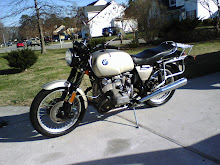Reference: Troubleshoot Turn Signal Relay - Turn Signal works, indicator flashes once and turns off. Hella DOT TBB 26 1-4x21W-12V 4DB 002 479-08 (A)71315 See Standard Troubleshooting Disclaimer on Main Page
Odd thing. I finally think I had one of those experiences we were told we would someday have. It was like the scene in Red Planet when Val Kilmer says (trying to figure out their way to the Mars Habitat Shelter before their air runs out) :"This is it. That moment our teachers said that someday algebra would save our lives". I now know a bit more about the flasher relay than I would like and I think physics saved me $59.
Removing the fairing was pretty simple actually. As to the turn signals, they used to be up on the fairing and had two wires each - a hot and a ground. The ground went back to the 31 block (the brown one on the bottom - brown as ground). So when the light was on its circuit was fairly clean although connectors can create some resistance. Lets just consider this the 'normal state' of that circuit.
How does a turn signal work? There are several good sites - check out the Vespa repair site. It has a fine
explanation.


Basically for this troubleshooting you need to know that there are two magnetic coils in the relay that serve to interrupt the circuit. One is associated with the lights and one acts in parallel and runs the little turn signal indicator light in the instrument console.
When I went to the stalk lights I increased the resistance on the circuit since they are now grounded through the frame and not the block. This affected the behavior of the capacitor in the relay. It apparently had enough juice to pull down its own coil repeatedly, but after the first discharge it failed to provide adequate amps to the second coil (indicator on instrument cluster) to allow it to repeat. So when you turn on the signal it works, but the indicator blinks once and then does not blink again.
I opened up the relay by spreading the base of the cap and examined the relay. Be VERY GENTLE. These things can bounce around all day, but there are some very fine parts that if touched roughly can damage the entire piece. After a couple of days learning about relays and looking at this problem I did the scientific thing of...(See Standard Disclaimer)...placing my fingernail behind the bar that completes the signal and push it about 1/64th of an inch closer to its coil. Bingo! It started to work just fine. So I could either 1) adjust the rest for this bar and bend it closer and reduce the travel distance...or 2) adjust the spring tension and and make it easier to move the bar. I did 2) since it looked like the spring was designed to have its tension adjusted. That's it... a $59 replacement avoided. Clean it up with electronic parts cleaner, grease it with some dielectric grease to preserve and clip it back into the bike. Good riding!

 When I bought the bike the kill switch was functioning but very...very sensitive. As well the end of the plastic thumb lever was broken off. Initially I rebuilt the broken piece using a plastic epoxy putty. The switch had become finicky and rather than experience one of those embarrassing and dangerous "surprise engine kills" while going down the road and inadvertently touching the kill switch with a winter glove while adjusting the mirror stalk -does it sound like this may have happened to me? - I took the switch apart and did some maintenance to it. I'll blog that separately. So, the plastic thumb part was weakened as I attempted to trouble shoot the switch. I cut a trough into the back side of the switch and fitted in a piece of 6d finishing nail.
When I bought the bike the kill switch was functioning but very...very sensitive. As well the end of the plastic thumb lever was broken off. Initially I rebuilt the broken piece using a plastic epoxy putty. The switch had become finicky and rather than experience one of those embarrassing and dangerous "surprise engine kills" while going down the road and inadvertently touching the kill switch with a winter glove while adjusting the mirror stalk -does it sound like this may have happened to me? - I took the switch apart and did some maintenance to it. I'll blog that separately. So, the plastic thumb part was weakened as I attempted to trouble shoot the switch. I cut a trough into the back side of the switch and fitted in a piece of 6d finishing nail. Covered it up with epoxy and Viola...good for another 30 years.
Covered it up with epoxy and Viola...good for another 30 years.










